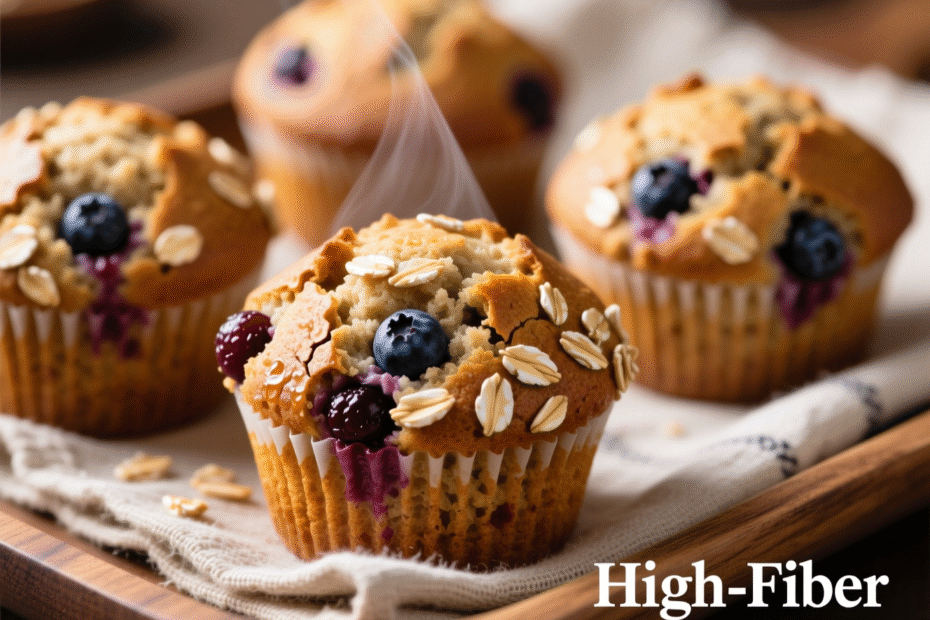Imagine biting into a warm, tender muffin that not only satisfies your sweet tooth but also fuels your body with wholesome, fiber-rich ingredients. Sounds too good to be true? Think again. High-fiber muffins made with oats and berries are not just a treat—they’re a smart, delicious way to support your digestive health, maintain steady energy levels, and even manage your weight. In today’s fast-paced world, where convenience often trumps nutrition, finding snacks that are both healthy and satisfying can feel like a challenge. That’s where this humble yet mighty muffin comes in.
In this article, we’ll explore why fiber matters more than you might think, how oats and berries team up to create a nutritional powerhouse, and why baking your own muffins at home is easier—and more rewarding—than you imagine. We’ll also share practical tips for customizing your recipe, avoiding common baking pitfalls, and making these muffins a regular part of your routine.
Whether you’re a busy parent, a health-conscious professional, or simply someone who loves a good homemade snack, you’ll find plenty of value in these pages. So, preheat your oven and get ready to discover how a simple batch of muffins can make a big difference in your daily wellness.
Why Fiber Should Be a Non-Negotiable in Your Diet
Fiber is one of those nutrients that often flies under the radar—until you realize just how essential it is. The average adult needs about 25 to 38 grams of fiber per day, depending on age and gender, yet most people consume less than half that amount. This shortfall isn’t just about occasional constipation; low fiber intake is linked to a higher risk of heart disease, type 2 diabetes, and even certain cancers.
But here’s the good news: increasing your fiber intake doesn’t require drastic changes. Small, consistent choices—like swapping a sugary pastry for a high-fiber muffin—can add up over time. Fiber slows digestion, helping you feel full longer and preventing blood sugar spikes. It also feeds the beneficial bacteria in your gut, supporting a healthy microbiome that influences everything from immunity to mood.
Oats and berries, the stars of our muffin recipe, are two of the best natural sources of dietary fiber. A single cup of cooked oats delivers about 4 grams of fiber, while a cup of mixed berries (like blueberries, raspberries, and blackberries) can provide 6 to 8 grams—and that’s before you even add flaxseeds, chia seeds, or whole wheat flour. By baking with these ingredients, you’re not just making a snack—you’re crafting a functional food that works for your body.
The Dynamic Duo: Oats and Berries in Perfect Harmony
Oats and berries might seem like a classic combo, but their partnership goes far beyond taste. Together, they create a synergy that amplifies their individual health benefits. Oats are rich in beta-glucan, a type of soluble fiber known to lower LDL (“bad”) cholesterol and improve heart health. Berries, on the other hand, are bursting with antioxidants, particularly anthocyanins, which give them their vibrant colors and help combat inflammation and oxidative stress.
When you bake them into muffins, you preserve much of their nutritional value—especially if you avoid overmixing the batter and bake at moderate temperatures (around 350°F or 175°C). Plus, the natural sweetness of berries reduces the need for added sugar, making your muffins lower in calories and gentler on your blood sugar.
Here’s a practical tip: use old-fashioned rolled oats instead of instant oats. They hold their texture better during baking and contain more fiber. And when it comes to berries, frozen works just as well as fresh—sometimes even better, since they’re flash-frozen at peak ripeness. Just be sure to toss them in a bit of flour before folding them into the batter to prevent sinking.
You can also get creative: swap blueberries for chopped strawberries in summer, or add a handful of blackberries in the fall. Each variation brings a new flavor profile while keeping the fiber content high and the glycemic load low.
From Store-Bought to Homemade: Why Baking Your Own Muffins Makes a Difference
Let’s be honest—most store-bought “healthy” muffins are anything but. A typical blueberry muffin from a coffee shop can pack 400–500 calories, 30+ grams of sugar, and barely 2 grams of fiber. That’s more sugar than a candy bar and less fiber than a slice of whole wheat bread!
When you bake at home, you take back control. You decide what goes into your muffins—and what stays out. No hidden hydrogenated oils, no high-fructose corn syrup, no artificial preservatives. Instead, you can use whole grain flours, natural sweeteners like maple syrup or mashed banana, and healthy fats like avocado oil or Greek yogurt.
Plus, homemade muffins are surprisingly easy to make. With just one bowl and about 10 minutes of prep time, you can whip up a batch that lasts all week. Store them in an airtight container at room temperature for up to three days, or freeze them for up to three months. Need a quick breakfast? Pop one in the microwave for 20 seconds, and you’re good to go.
And don’t worry if you’re not a seasoned baker. These muffins are forgiving. Overmix the batter a little? They’ll still taste great. Forget the baking powder? They might be denser, but still nutritious. The beauty of this recipe lies in its flexibility—and its ability to turn simple, wholesome ingredients into something truly satisfying.
Customizing Your Muffins for Taste, Nutrition, and Lifestyle Needs
One of the best things about high-fiber muffins is how adaptable they are. Whether you’re vegan, gluten-sensitive, or just looking to boost your protein intake, there’s a tweak for every need.
For gluten-free eaters: Swap regular oats for certified gluten-free oats and use a blend of almond flour and oat flour instead of wheat flour. Just be sure your baking powder is also gluten-free.
For vegans: Replace eggs with flax eggs (1 tablespoon ground flaxseed + 3 tablespoons water per egg) and use plant-based yogurt or applesauce as a binder.
Want more protein? Add a scoop of unflavored or vanilla protein powder, or stir in a handful of chopped nuts or seeds like walnuts, sunflower seeds, or pumpkin seeds. These additions not only increase satiety but also add crunch and flavor.
Prefer less sweetness? Reduce the sweetener by half and rely on the natural sugars in very ripe bananas or unsweetened applesauce. You’ll be surprised how flavorful the berries and oats can be on their own.
You can even turn these muffins into a meal-prep staple. Double the batch on Sunday, freeze half, and thaw as needed throughout the week. They’re perfect for school lunches, post-workout snacks, or an afternoon pick-me-up that won’t leave you crashing.
And remember: small changes yield big results. Swapping one processed snack for a fiber-rich muffin each day can improve your digestion, stabilize your energy, and even support long-term weight management—all without feeling like you’re “on a diet.”
The Bigger Picture: How One Muffin Can Spark a Healthier Lifestyle
It’s easy to underestimate the power of a single food choice. But that high-fiber muffin? It’s more than breakfast—it’s a statement. A statement that says, “I care about what I put into my body.” It’s a small act of self-respect in a world that often prioritizes speed over substance.
Think of it this way: every time you choose whole ingredients over processed ones, you’re training your palate to appreciate real food. Over time, sugary, artificial flavors start to taste overwhelming, while the natural sweetness of fruit and the earthy comfort of oats become deeply satisfying. This shift doesn’t happen overnight, but it begins with choices like this one.
Moreover, baking at home fosters mindfulness. Measuring ingredients, smelling the berries as they bake, sharing muffins with family or friends—these moments reconnect us to the joy of eating. In a culture dominated by drive-thrus and delivery apps, that connection is precious.
And let’s not forget the environmental angle. Homemade muffins mean less packaging waste, fewer preservatives in landfills, and support for sustainable agriculture—especially if you choose organic oats and locally grown berries when possible.
So yes, this is just a muffin. But it’s also a gateway—to better habits, to kitchen confidence, to a more intentional way of living. One bite at a time.
Conclusion
High-fiber muffins with oats and berries are far more than a tasty breakfast option—they’re a simple, powerful tool for improving your daily nutrition. We’ve explored why fiber is essential for long-term health, how oats and berries complement each other both nutritionally and flavor-wise, and why making your own muffins at home gives you control over ingredients and quality. We’ve also shared practical ways to customize your recipe to fit dietary needs, lifestyle goals, and personal preferences.
The beauty of this approach lies in its simplicity. You don’t need fancy equipment, exotic ingredients, or hours in the kitchen. Just a few wholesome staples and a willingness to try something new. And the payoff? Better digestion, sustained energy, reduced cravings, and the quiet satisfaction of knowing you’ve nourished yourself well.
So why not give it a go this weekend? Whip up a batch, freeze a few for busy mornings, and notice how your body—and your taste buds—respond. You might just find that healthy eating doesn’t have to be hard… it can be deliciously easy.
We’d love to hear from you! Have you tried making high-fiber muffins before? What’s your favorite add-in—chia seeds, dark chocolate chips, or maybe a dash of cinnamon? Share your tips, tweaks, or questions in the comments below. Let’s inspire each other to bake smarter, eat better, and live well—one muffin at a time.

Thayná Alves is an influential digital content creator who has carved out a significant space in the realms of technology, finance, and entrepreneurship. Through her blog, Newbacker.com , she stands out as an authentic and accessible voice for individuals seeking practical information about investments, innovation, and emerging trends in the financial market.
